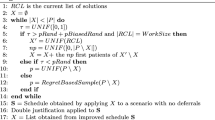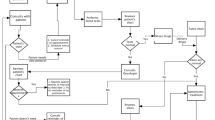Abstract
This research addresses a scheduling problem for chemotherapy patients, which is divided in two subproblems: patient scheduling on an infinite horizon and daily patient scheduling. We consider the requirement for available laboratory hours to prepare the medicine for every patient as an additional complexity. A methodology was formulated that addresses the problem in two stages. The first one is based on previous research and implements a scheduling policy for chemotherapy. The result of this first stage is the input for the second stage, which is addressed by generating treatment patterns. The benefits of both stages of the proposed methodology are evaluated for two real cases, one of them in the Chemotherapy Division of Hospital Salvador, and the other in the Cancer Center, of the Clinical Hospital of the Pontificia Universidad Católica de Chile, both in Santiago, Chile. Regarding the costs’ impact, the method proposed manages to reduce 20% and 17% the operational costs in these cases, due to less extra treatment hours needed. On the other hand, the proposed daily scheduling method for patients presents an improvement of 21% and 9% in care slots usage and 22% and 17% in laboratory slots usage for an average demand day, which translates in a reduction of both extra hours used and workday duration, for the case of the Chemotherapy Division and Cancer Center, respectively.





Similar content being viewed by others
References
Anghinolfi, D., & Paolucci, M. (2007). Parallel machine total tardiness scheduling with a new hybrid metaheuristic approach. Computers & Operations Research, 34(11), 3471–3490.
Bernard, B., & Sweeney, C. J. (2015). Diagnosis and treatment of testicular cancer: A clinician’s perspective. Surgical pathology clinics, 8(4), 717–723.
Bilge, Ü., Kıraç, F., Kurtulan, M., & Pekgün, P. (2004). A tabu search algorithm for parallel machine total tardiness problem. Computers & Operations Research, 31(3), 397–414.
Bos, A., van Erning, F., van Gestel, Y., Creemers, G., Punt, C., Van Oijen, M., et al. (2015). Timing of adjuvant chemotherapy and its relation to survival among patients with stage III colon cancer. European Journal of Cancer, 51(17), 2553–2561.
Burke, E. K., De Causmaecker, P., Berghe, G. V., & Van Landeghem, H. (2004). The state of the art of nurse rostering. Journal of scheduling, 7(6), 441–499.
Cataldo, A., Ferrer, J. C., Miranda, J., Rey, P. A., & Sauré, A. (2017). An integer programming approach to curriculum-based examination timetabling. Annals of Operations Research, 258(2), 369–393.
Cayirli, T., & Veral, E. (2003). Outpatient scheduling in health care: A review of literature. Production and operations management, 12(4), 519–549.
Chen, Z., King, W., Pearcey, R., Kerba, M., & Mackillop, W. J. (2008). The relationship between waiting time for radiotherapy and clinical outcomes: A systematic review of the literature. Radiotherapy and Oncology, 87(1), 3–16.
Condotta, A., & Shakhlevich, N. (2014). Scheduling patient appointments via multilevel template: A case study in chemotherapy. Operations Research for Health Care, 3(3), 129–144.
Conforti, D., Guerriero, F., & Guido, R. (2008). Optimization models for radiotherapy patient scheduling. 4OR, 6(3), 263–278.
Conforti, D., Guerriero, F., & Guido, R. (2010). Non-block scheduling with priority for radiotherapy treatments. European Journal of Operational Research, 201(1), 289–296.
Du, J., & Leung, J. Y. T. (1990). Minimizing total tardiness on one machine is np-hard. Mathematics of Operations Research, 15(3), 483–495.
Durán, G., Guajardo, M., Miranda, J., Sauré, D., Souyris, S., Weintraub, A., et al. (2007). Scheduling the chilean soccer league by integer programming. Interfaces, 37(6), 539–552.
Ernst, A. T., Jiang, H., Krishnamoorthy, M., & Sier, D. (2004). Staff scheduling and rostering: A review of applications, methods and models. European Journal of Operational Research, 153(1), 3–27.
González, J., Ferrer, J. C., Cataldo, A., & Rojas, L. (2018). A proactive transfer policy for critical patient flow management. Health Care Management Science. https://doi.org/10.1007/s10729-018-9437-7.
Graham, R. L., Lawler, E. L., Lenstra, J. K., & Kan, A. R. (1979). Optimization and approximation in deterministic sequencing and scheduling: A survey. Annals of Discrete Mathematics, 5, 287–326.
Griffiths, J. D., Williams, J. E., & Wood, R. M. (2012). Scheduling physiotherapy treatment in an inpatient setting. Operations Research for Health Care, 1(4), 65–72.
Gupta, D., & Denton, B. (2008). Appointment scheduling in health care: Challenges and opportunities. IIE Transactions, 40(9), 800–819.
Jiang, H., & Barnhart, C. (2009). Dynamic airline scheduling. Transportation Science, 43(3), 336–354.
Lara, B. A., Cataldo, A., Castro, R., Aguilera, P. R., Ruiz, C., & Andresen, M. (2016). The impact of a better coordination between emergency and intensive care units in the care of critically ill patients. Revista medica de Chile, 144(7), 911–917.
Le, M. D., Nguyen, M. H. N., Baril, C., Gascon, V., & Dinh, T. B. (2015). Heuristics to solve appointment scheduling in chemotherapy. In: 2015 IEEE RIVF international conference on computing & communication technologies-research, innovation, and vision for the future (RIVF) (pp. 59–64). IEEE.
Li, K., Shi, Y., Sl, Yang, & By, Cheng. (2011). Parallel machine scheduling problem to minimize the makespan with resource dependent processing times. Applied Soft Computing, 11(8), 5551–5557.
Liu, N., Ziya, S., & Kulkarni, V. G. (2010). Dynamic scheduling of outpatient appointments under patient no-shows and cancellations. Manufacturing & Service Operations Management, 12(2), 347–364.
Mallor, F., & Azcárate, C. (2014). Combining optimization with simulation to obtain credible models for intensive care units. Annals of Operations Research, 221(1), 255–271.
Mazier, A., Billaut, J. C., & Tournamille, J. F. (2010). Scheduling preparation of doses for a chemotherapy service. Annals of Operations Research, 178(1), 145–154.
McLaughlin, J. M., Anderson, R. T., Ferketich, A. K., Seiber, E. E., Balkrishnan, R., & Paskett, E. D. (2012). Effect on survival of longer intervals between confirmed diagnosis and treatment initiation among low-income women with breast cancer. Journal of Clinical Oncology, 30(36), 4493–4500.
Ogulata, S. N., Koyuncu, M., & Karakas, E. (2008). Personnel and patient scheduling in the high demanded hospital services: A case study in the physiotherapy service. Journal of Medical Systems, 32(3), 221–228.
O’Rourke, N., & Edwards, R. (2000). Lung cancer treatment waiting times and tumour growth. Clinical Oncology, 12(3), 141–144.
Patrick, J., & Puterman, M. L. (2007). Improving resource utilization for diagnostic services through flexible inpatient scheduling: A method for improving resource utilization. Journal of the Operational Research Society, 58(2), 235–245.
Patrick, J., Puterman, M. L., & Queyranne, M. (2008). Dynamic multipriority patient scheduling for a diagnostic resource. Operations Research, 56(6), 1507–1525.
Petrovic, S., & Leite-Rocha, P. (2008). Constructive and grasp approaches to radiotherapy treatment scheduling. In: World congress on engineering and computer science 2008, WCECS’08. Advances in electrical and electronics engineering-IAENG special edition of the 2008 (pp. 192–200). IEEE.
Ragaz, J., Olivotto, I. A., Spinelli, J. J., Phillips, N., Jackson, S. M., Wilson, K. S., et al. (2005). Locoregional radiation therapy in patients with high-risk breast cancer receiving adjuvant chemotherapy: 20-year results of the british columbia randomized trial. Journal of the National Cancer Institute, 97(2), 116–126.
Santibáñez, P., Aristizabal, R., Puterman, M. L., Chow, V. S., Huang, W., Kollmannsberger, C., et al. (2012). Operations research methods improve chemotherapy patient appointment scheduling. Joint Commission Journal on Quality and Patient Safety, 38(12), 541–553.
Sauré, A., Patrick, J., Tyldesley, S., & Puterman, M. L. (2012). Dynamic multi-appointment patient scheduling for radiation therapy. European Journal of Operational Research, 223(2), 573–584.
Song, S., Rudra, S., Hasselle, M. D., Dorn, P. L., Mell, L. K., Mundt, A. J., et al. (2013). The effect of treatment time in locally advanced cervical cancer in the era of concurrent chemoradiotherapy. Cancer, 119(2), 325–331.
Warburg, V., Hansen, T. G., Larsen, A., Norman, H., & Andersson, E. (2008). Dynamic airline scheduling: An analysis of the potentials of refleeting and retiming. Journal of Air Transport Management, 14(4), 163–167.
Wren, A. (1995). Scheduling, timetabling and rostering-a special relationship? In: International conference on the practice and theory of automated timetabling (pp. 46–75). Springer.
Yalaoui, F., & Chu, C. (2002). Parallel machine scheduling to minimize total tardiness. International Journal of Production Economics, 76(3), 265–279.
Acknowledgements
The authors of this research thank the National Commission for Scientific and Technological Research (CONICYT) for the financial support provided through the FONDEF Project CA13I10319.
Author information
Authors and Affiliations
Corresponding author
Rights and permissions
About this article
Cite this article
Ramos, C., Cataldo, A. & Ferrer, J. Appointment and patient scheduling in chemotherapy: a case study in Chilean hospitals. Ann Oper Res 286, 411–439 (2020). https://doi.org/10.1007/s10479-018-3085-7
Published:
Issue Date:
DOI: https://doi.org/10.1007/s10479-018-3085-7




